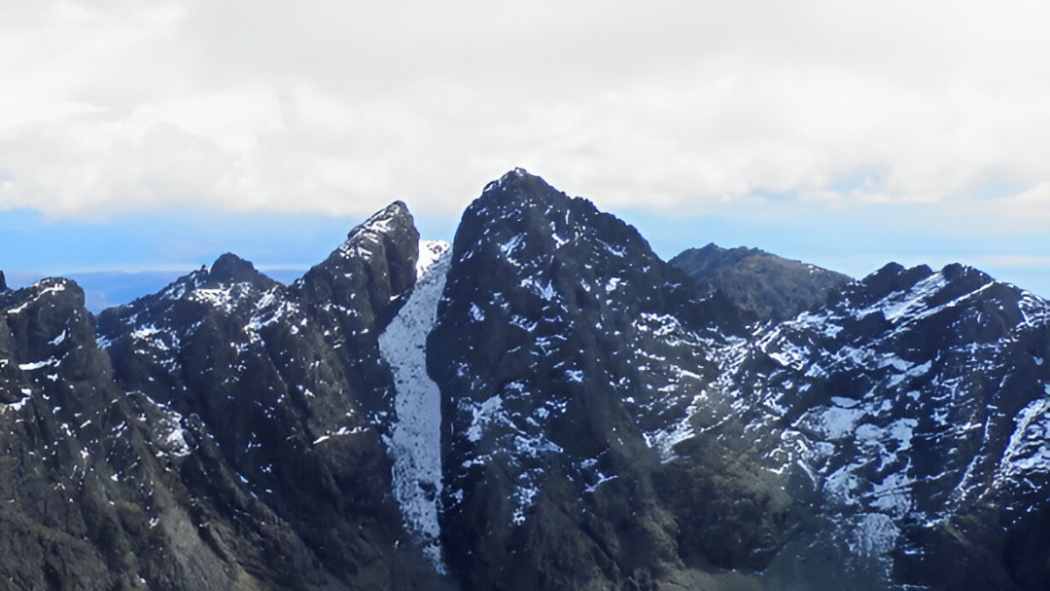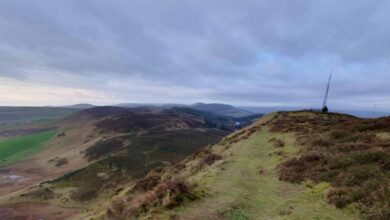
Nestled within the heart of Scotland’s rugged and untamed landscape lies Sgurr Alasdair, the highest peak on the Isle of Skye and the most prominent summit in the entire Cuillin mountain range. Towering at an elevation of 992 metres (3,255 feet), this mountain stands as a natural monument to Scotland’s geological drama and mountaineering heritage. It is not merely a peak—it is a test of endurance, a celebration of natural grandeur, and a symbol of Scotland’s indomitable spirit.
The name Sgurr Alasdair derives from Scottish Gaelic, meaning “Alexander’s Peak.” It is said to commemorate Alexander Nicolson, who achieved the first recorded ascent of the mountain in 1873. Since then, Sgurr Alasdair has captivated the imagination of climbers, hikers, and geologists alike, each seeking to experience the awe and mystery of this formidable mountain.
Table of Contents
ToggleThe Location and Landscape
Sgurr Alasdair is located within the Black Cuillin, a jagged range of volcanic rock that dominates the southern region of the Isle of Skye. The Cuillin Hills are renowned for their dramatic ridges, steep cliffs, and complex topography, often described as the most alpine terrain in the British Isles. The mountain’s geographical coordinates position it within a remote and awe-inspiring setting, overlooking Glen Brittle to the west and the sea lochs beyond.
The Cuillin range itself is divided into two main sections: the Black Cuillin and the Red Cuillin. While the Red Cuillin are gentler and rounded, the Black Cuillin, where Sgurr Alasdair resides, are sharper, darker, and composed mainly of gabbro—a coarse-grained igneous rock that provides exceptional friction, making it ideal for climbing. This unique geological composition gives the Black Cuillin their distinctive dark hue and makes them both inviting and intimidating to mountaineers.
Historical Significance
Sgurr Alasdair holds deep historical and cultural importance. The mountain’s name, honouring Alexander Nicolson, serves as a tribute to human curiosity and perseverance. Nicolson’s ascent in the late 19th century marked the beginning of an era of exploration on the Isle of Skye, as mountaineers from across the world began to recognise Scotland as a premier destination for adventure and discovery.
Over time, the Cuillin range became a rite of passage for Scottish climbers. The harsh weather, unpredictable mists, and exposed ridges made each ascent a challenge not just of skill, but of spirit. For locals, Sgurr Alasdair also represents a deep connection to nature and the Gaelic tradition—a reminder of the relationship between people and the untamed highlands that define much of Scotland’s character.
Geological Composition
The geological story of Sgurr Alasdair is as fascinating as its physical appearance. The mountain is primarily made of gabbro, an intrusive igneous rock that crystallised deep underground millions of years ago. This rock type is particularly beloved by climbers for its rough texture, which offers excellent grip, even in wet conditions. The ruggedness of the terrain owes its shape to ancient volcanic activity and subsequent glacial erosion, which carved deep corries and razor-sharp ridges into the Cuillin range.
In contrast to other mountain ranges in Britain, the Cuillin’s volcanic origins give them a distinctive appearance. The dark cliffs, knife-edge ridges, and scree slopes tell a geological story that dates back to the Paleogene period. Over time, erosion sculpted the Cuillin into the breathtaking landscape seen today, making Sgurr Alasdair both a natural wonder and a geological treasure trove.
Climbing and Routes
Climbing Sgurr Alasdair is not a simple undertaking. It demands both physical fitness and a strong sense of mountaineering awareness. The most popular route to the summit begins from Glen Brittle, leading through Coire Lagan, one of Skye’s most spectacular corries. From there, climbers ascend the famous Great Stone Chute, a steep, loose gully of scree that leads almost directly to the ridge just below the summit.
The Great Stone Chute is both the easiest and the most notorious section of the climb. It stretches for several hundred metres and consists of unstable rock fragments that shift underfoot, making progress slow and exhausting. However, once the top of the chute is reached, a short but exhilarating scramble along the east ridge brings climbers to the summit.
For experienced mountaineers, there are alternative and more challenging routes. Some approach Sgurr Alasdair as part of a Cuillin Ridge Traverse, a continuous journey along the entire ridge that links all the major peaks in one of the most difficult mountaineering challenges in the United Kingdom. Others prefer the technical climbing routes that tackle the mountain’s sheer rock faces. Regardless of the chosen path, reaching the summit is a deeply rewarding experience.
The Experience of the Ascent
Ascending Sgurr Alasdair is as much a psychological challenge as a physical one. The mountain’s steep slopes, unpredictable weather, and frequent mist require patience, confidence, and good judgement. Visibility can change in moments, transforming a clear path into a world of swirling grey. Climbers must rely on their instincts, experience, and preparation to navigate safely.
Yet, when the clouds lift, the reward is extraordinary. From the summit, panoramic views stretch across the Cuillin ridge, the sea lochs, and distant islands. On a clear day, you can see the Outer Hebrides to the west and the Scottish mainland to the east. The sense of isolation and elevation creates a moment of profound connection with nature—an experience many describe as spiritual.
Flora and Fauna
While the upper slopes of Sgurr Alasdair are barren and rocky, the lower elevations support a surprising diversity of plant and animal life. The valleys and corries around Glen Brittle are home to hardy alpine flora, including mosses, lichens, and heather. In the spring and summer months, wildflowers bloom, adding patches of colour to the otherwise grey and green landscape.
Birdlife is another highlight of the area. Golden eagles, peregrine falcons, and ravens are often seen soaring above the Cuillin ridges. On the ground, red deer and mountain hares inhabit the lower slopes, while otters and seals can be spotted along the coastal areas near Glen Brittle. This rich biodiversity adds another layer of wonder to the mountain environment.
Weather and Safety
The Isle of Skye is famous for its rapidly changing weather conditions. Sunshine can turn to heavy rain or mist within minutes, and temperatures at the summit are often much colder than at sea level. For this reason, climbers must come well-prepared with appropriate clothing, sturdy footwear, and navigation tools.
Safety is paramount when tackling Sgurr Alasdair. The Great Stone Chute, though popular, is prone to rockfall, especially when other climbers are above. Helmets and spacing between groups are essential to minimise risk. Moreover, even in summer, wet conditions can make the gabbro surfaces slippery. Winter ascents, on the other hand, require full mountaineering gear, including crampons and ice axes, as snow and ice can transform the terrain into a technical climb.
The Cultural Impact
Beyond its physical and geological allure, Sgurr Alasdair holds a cultural significance that extends far beyond the Isle of Skye. The mountain embodies the essence of Scotland’s wild beauty—a place where myth, history, and nature converge. It has been immortalised in countless photographs, poems, and travel writings, each attempting to capture its elusive spirit.
For many Scottish people, mountains like Sgurr Alasdair represent more than just peaks to be conquered; they are sacred spaces that connect them to their heritage. The Gaelic language, the stories of explorers, and the traditions of the Highlands all find resonance in these high places. The mountain is, therefore, both a destination and a symbol of resilience and identity.
Visitor Tips and Modern Tourism
Today, Sgurr Alasdair attracts adventurers from all corners of the world. However, due to its difficulty, it remains a destination for serious walkers and climbers rather than casual tourists. Visitors typically base themselves in Glen Brittle, where campsites and hostels offer accommodation close to the trailhead.
When planning a trip, it is advisable to check weather forecasts, start early, and carry plenty of water and food. Maps and compasses are essential, as GPS signals can be unreliable in the deep corries. Hiring a local mountain guide is also a good option for those unfamiliar with the Cuillin terrain, ensuring a safer and more enjoyable experience.
The Reward of the Summit
Reaching the top of Sgurr Alasdair is not only a physical achievement but an emotional one. Standing on the highest point of the Isle of Skye, surrounded by panoramic views of mountains and sea, brings a sense of triumph and humility. The wind, the silence, and the vastness of the horizon remind climbers of nature’s power and timeless beauty.
It is this combination of challenge, beauty, and solitude that makes Sgurr Alasdair one of Scotland’s most revered mountains. Every ascent becomes a story of endurance and wonder—a journey that leaves an indelible mark on those who undertake it.
Conclusion
Sgurr Alasdair stands as a proud guardian of the Isle of Skye, a peak that commands respect and admiration. It is a mountain where nature reveals both its harshness and grace, where the climber’s courage meets the earth’s raw beauty. From its geological origins to its cultural legacy, every facet of Sgurr Alasdair tells a story of resilience and majesty.
For those who dare to ascend its slopes, the reward is not just the view from the top but the experience of being part of something greater—the living spirit of Scotland’s highlands. Whether admired from afar or climbed with determination, Sgurr Alasdair remains a timeless symbol of the wild, untamed heart of Scotland.



